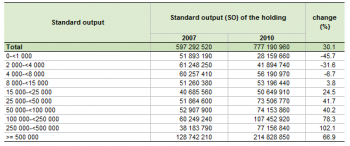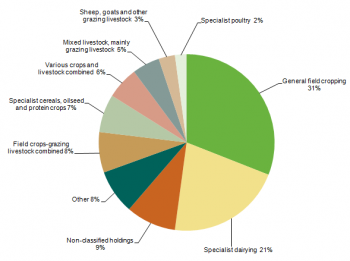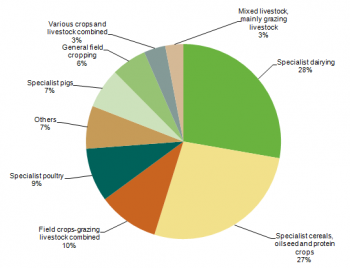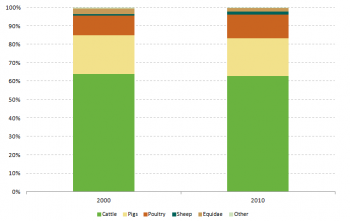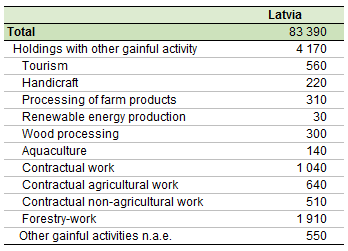Archive:Agricultural census in Latvia
- Data from Month year. Most recent data: Further Eurostat information, Main tables and Database.
This article is part of a series of country-specific essays on the results of the European Union (EU) Farm structure survey (FSS) 2010. The FSS collects information on the structural characteristics of the agricultural holdings (land use, livestock and labour force) and is carried out by all European Union Member States every 10 years as an [[[index.php/Agricultural_census|agricultural census]]], with two or three additional, intermediate sample surveys carried out in-between. In Latvia, the FSS 2010 was the second Agricultural census to be carried out according to European regulations. The present analysis of the farm structure includes a comparison with the FSS 2001, the first Agricultural census carried out according to Council regulations. Although the reference years of the Agricultural census in Latvia were 2001 and 2010 respectively, the common designation is Agricultural census 2000 and 2010.

Source: Eurostat (ef_kvaareg) (ef_ov_kvaa) (demo_pjan) and FSS, 2000 and 2010

Source: Eurostat (ef_kvaareg) (ef_ov_kvaa)

Source: Eurostat (ef_lu_ovcropaa) (ef_oluaareg)

Source: Eurostat (ef_lu_ovcropaa) (ef_oluaareg)

Source: Source: Eurostat (ef_pmhouscatlaa)
Main statistical findings
Key indicators
According to the FSS 2010 data, in Latvia the utilised agricultural area (UAA) represented roughly 28 % of the whole territory and it covered 1 796 290 hectares (see Table 1): after 2000, an increase of 25 % in the UAA was reported. The average size of the agricultural holdings doubled, growing from 10.2 ha in 2000 to 21.5 ha in 2010.
In terms of animal livestock expressed in livestock units (LSU), an increase of almost 7 % compared to 2010 was observed, amounting to 474 630 LSU.
The decrease in the number of holdings (-40.8 %) has had substantial effects on agricultural employment: between 2000 and 2010, the number of persons working in agriculture fell by 34 %, from 274 260 to 180 990. Accordingly, in 2010 the population working in agriculture (part time work included) represented 16 % of the economically active population of Latvia.[1]
Considering the overall increase of the UAA in Latvia, the ratio per inhabitant has increased as well: in 2010 there were 0.8 hectares of UAA on average per inhabitant, a 33 % increase compared to the 2000 figure, one of the highest recorded within the EU-27.
Agricultural holdings
Most agricultural holdings have less than 20 hectares in Latvia. According to the FSS 2010 data, 82 % of them had less than 20 ha of UAA and accounted for 27 % of the UAA of the whole country (Figure 1). In contrast, the majority (57 %) of the total UAA belonged to a small percentage of agricultural holdings (6 %) with a size of 50 hectares or more. Land ownership went through many changes due to political changes after the independence and also to the effects of the CAP.[2]
In particular, when compared to the FSS 2000 data, the number of farms with 100 hectares or more of UAA doubled in Latvia, to reach 2 570 in 2010. On the other end of the scale, all 3 120 holdings which in 2000 were recorded as not having UAA disappeared by 2010. Moreover, agricultural holdings with less than 2 hectares displayed a sharp decline, from 35 000 in 2000 to 9 590 in 2010 (-73 %).
Economic size of the farm
In 2010, the economic size of all Latvian agricultural holdings was EUR 777.2 million, a value calculated by adding all the standard output (SO) per hectare of crop and per head of livestock in a farm (see Table 2). Compared to the FSS 2007 value (EUR 597.3 million), the 2010 data represents a 30 % increase which to a great extent reflected the growth of the economic size of the largest farm classes. Indeed, the agricultural holdings with an economic size ranging from EUR 250 000 to EUR 499 999 recorded the highest increase (102.1 %); those with an economic size of EUR 100 000 up to EUR 249 999 recorded the second highest increase (78.3 %), while those with an economic size of EUR 500 000 or more grew by 66.9 %. At the other side of the scale, the farms with the smallest economic size (less than EUR 1 000 of SO) recorded the largest fall (-45.7 %).
In Latvia, the agricultural holdings with an economic size of EUR 100 000 of SO or more represented 51 % of the total standard output of the agricultural holdings in 2010.
Agricultural holding by main type of farming
In terms of the main area of production, holdings specialised in general field cropping represented the largest category in Latvia, according to the Agricultural census 2010, with a share of 31 % of the total number of holdings (see Figure 2). The farms classified as specialised in dairy farming accounted for 21 %, while those focusing on field crops-grazing and livestock combined contributed another 8 %, a share slightly higher than the one of the farms specialised in cereals, oilseed and protein crops (7 %) and the one of holdings producing various crops and livestock combined (6 %).
The imagie drawn in Figure 2 changes when ranking in terms of the economic size is made (see Figure 3). Indeed, when using the SO as a criterion 28 % of the total SO generated by all Latvian farms came from dairy farming in 2010. Agricultural holdings whose production was focused on cereals, oilseed and protein crops contributed a similar share (27 %). The contribution of those specialised in field crops-grazing livestock combined was 10 % of the total SO of the Latvian agricultural holdings, whereas farms specialised in poultry accounted for 9 %.
Land use
The utilised agricultural area (UAA) is the total area taken up by arable land, permanent grassland and meadow, as well as permanent crops and kitchen gardens used by the holdings, regardless of the type of tenure or whether it is used as a part of common land.
In absolute terms, the UAA of Latvia increased by 363 610 hectares between 2000 and 2010 (25.4 %). Accordingly, Latvia had 1 796 290 hectares of UAA in 2010.
Comparing the FSS 2010 data with those of 2000, the share of the area occupied by permanent grassland and meadows showed the largest increase (41 %) within the main categories of UAA, from 463 200 ha to 651 050 ha (or 36.2% of the total UAA – see Table 3) to the detriment of arable land, which increased less fast (+18.2%) and therefore lost shares (from 66.2% of the UAA in 2000 to 62.3% in 2010). In the other main categories, the area taken by kitchen gardens, which was nonexistent or non significant in 2000, recorded 16 670 hectares in 2010, thus accounting for 1 % of the country’s UAA. On the contrary, the area of permanent crops experienced a sharp drop, shifting from 21 730 ha to 8 510 ha (-61 %), and represented only 0.5 % of the Latvian UAA in 2010.
Arable land
In Latvia, the land that is regularly worked (ploughed or tilled), generally under a system of crop rotation, represented 62 % of the total UAA in 2010: it accounted for 66 % of the UAA in 2000. In absolute terms though the arable land increased from 947 760 ha in 2000 to 1 119 960 ha in 2010. Looking at the sub categories, cereals (30 % of UAA in 2010) and fodder crops (19 %) remain the most important. The industrial crops experienced a very sharp increase, from 10 950 ha in 2000 (0.8 % of UAA) to 116 840 ha in 2010 (6 % of UAA).
Permanent grassland and meadows
Between 2000 and 2010 the area of permanent grassland and meadows grew by almost 41 %: from 463 200 ha to 651 050 ha. The area dedicated to pasture and meadows dropped by 68 %. In contrast, due to methodological reasons, the land dedicated to rough grazing as well as the permanent grassland and meadows not used for production and eligible for subsidies grew largely in absolute terms: + 349 950 ha the former, + 155 020 ha the latter.
Permanent crops
Of lesser importance for Latvia, the area under permanent crops recorded a sharp downturn - from 21 730 ha in 2000 to only 8 510 ha in 2010 (-61 %) - which partially could be the outcome of the decrease of small farms. In 2010, the land dedicated to permanent crops was essentially taken by fruit and berry plantations as nurseries only took a total area of 250 ha.
Livestock
Statistics on livestock use two different units of measurement: the number of heads (number of animals) and the livestock units (LSU), the latter allowing comparison between the different types.
The population of livestock increased by 6.6 % over the period 2000-2010. Accordingly, there were 0.21 LSU per inhabitant in Latvia in 2010, a slightly smaller value was registered in 2000 (0.19). The 6.6% increase in livestock population was the combined effect of the increase for certain species and the drop in others. In terms of LSU, sheep more than doubled their value, from 3 750 LSU in 2000 to 8 430 LSU in 2010 (see Table 4); poultry increased by 31.4 %, while cattle grew only marginally (+4.8 %). Conversely, figures for Equidea registered a sharp decline (-41.5 %).
Table 4 further shows that the number of agricultural holdings with livestock halved over the 2000-2010 period (from 97 760 to 48 700), suffering a decrease even sharper than the one displayed by the total number of farms (-40.8%). Far from being evenly distributed, this decrease affected the smaller holdings rather than the larger ones. According to the FSS 2010 data, the farms with no LSU dropped by 56 %; the decrease for the agricultural holdings with less than 5 LSU and those with more than 5 and less than 10 LSU was only marginally smaller (-55 % and -50% respectively). The number of holdings with more than 10 and less than 15 LSU fell by 24 %.
On the contrary, larger holdings increased substantially: farms with a number of LSU ranging from 50 to 99 LSU increased by 230 %, those with 100 to 499 LSU by 117 %. The increase for the largest category (with 500 or more LSU) was less outspoken (+ 33 %).
Labour force
Between 2000 and 2010, the labour force employed in the agricultural sector decreased in Latvia. Indeed, the regular labour force in the agricultural sector amounted to 180 990 persons in 2010, a 34 % drop compared to 2000 data, when 274 260 persons were recorded (see Table 5). This figure changes when looking at the labour force in terms of the annual work unit (AWU): here the decrease reached -40.9 %. In absolute terms the labour force shifted from 143 220 AWU in 2000 to 84 640 AWU in 2010. A very substantial drop was also registered in the labour force employed on a non-regular basis (-73.6 %).
Management practices
Type of tenure
As displayed in Table 6, in 2010 the majority of the Latvian UAA (68.6 %) belonged to farmers who actually worked on their land: 1 231 370 hectares. On the contrary, 564 920 hectares (share of 31.4 %) were cultivated by the tenants.
Irrigation
Considering the prevailing climatic conditions, irrigation is a lesser issue in Latvia: in 2010, there were 1 140 hectares of irrigable area in Latvia, a substantial increase in relative terms as only 560 ha were registered in 2000. Over the total irrigable area, 710 hectares were irrigated at least once a year.
According to the 2010 data, temporary and permanent grass made up 51 % of the total irrigated area of the country. Fruit and berry plantations were the second most irrigated crop (26 %), followed by potatoes (19 %).
In 2010, 72 970 cubic metres of water were used for irrigation in Latvia – excluding the water used for kitchen gardens. It must be noted that this is an estimate which takes into account several factors and was calculated for the first time within the 2010 FSS.
Animal housing
The FSS 2010 data revealed that 35 100 holdings raised 394 340 heads of cattle in Latvia; among these holdings only 6 980 had at least 10 heads of cattle. In the case of the Survey on Agricultural production methods (SAPM), these were the only farms that were included in the survey on the cattle housing and they represented 309 670 heads of cattle.
In 2010, the type of cattle housing where the animals are tied to their place in a stable with solid dung and liquid manure was the most frequent in Latvia (321 770 places). Loose housing with solid dung and liquid manure was the second most common type of cattle housing (70 880 places), followed by loose housing with slurry (18 880 places). Finally, stanchion tied stable with slurry was the least common type of cattle housing. The values over 100% showed in Table 7 highlight that the housing capability of Latvia outnumbered the amount of heads of cattle.
Other gainful activities
As exhibited in Table 8, the Agricultural census 2010 data show that 5% of all Latvian holdings (4 170) have other gainful activities. Representing a small share of the whole population of agricultural holdings, these farms recorded activities other than farm work, directly related to the holding and having an economic impact on the farm.
Information on other gainful activities was collected in the form of eleven category types depending on their characteristics. According to the FSS 2010 data, the most common one was forestry-work (1 910), followed by contractual work (1 040 holdings) and tourism (560 holdings). When analysing data on other gainful activities, it must be noted that holdings involved in more than one gainful activity were counted more than once.
Organic farming
Organic agriculture is an ecological production management system that promotes and enhances biodiversity, biological cycles and soil biological activity. It is based on the minimal use of off-farm inputs and on management practices that restore, maintain or enhance ecological harmony.
In Latvia, the number of agricultural holdings practising organic farming dropped over the 2000-2005 timeframe: while there were 5 130 holdings conducting organic farming in 2000, only 440 were still recorded in 2005. The number of farm practicing organic farming increased again in 2007 (to reach 2 970 holdings), with a marginal decrease by 2010 (2 880 holdings). The image looks far more positive when considering the UAA under organic farming: it increased close to 10 fold from 13 320 hectares in 2003 to 125 970 hectares in 2010. Accordingly the share of organic farming amounted to 7 % of the country’s total UAA in 2010.
Data sources and availability
Methodological notes
The Central Statistical Bureau of Latvia (CSB) was the main institution responsible for carrying out the FSS and the SAPM. The Ministry of Agriculture also participated in the collection of information. Moreover, on behalf of the Ministry of Agriculture, the Latvian Rural Advisory and Training Centre (LRATC) took part in the Agricultural census.
In Latvia, in compliance with the European Parliament and Council Regulation Regulation 1166/2008, the FSS 2010 was conducted in the form of a Census. Moreover, the first Agricultural census organised in compliance with the requirements of the European Union legislation took place in 2001, followed by the Farm Structure sample Surveys in 2003, 2005 and 2007.
Survey on agricultural production methods (SAPM)
In 2010 a unique survey was carried out together with the Agricultural census: the Survey on agricultural productions methods (SAPM). This survey collected data at regional level needed to establish agri-environmental indicators as indicated in COM final 508/2006 and to evaluate the greening of the Common agricultural policy.
Data were collected according to specifications listed in Annex V of Regulation 1166/2008, namely data on tillage methods, soil conservation, landscape features, animal grazing, animal housing, manure application, manure storage and treatment facilities and irrigation.
In Latvia, the SAPM was conducted as sample survey, the sample size was 20 005 agricultural holdings. It targeted all the economically active agricultural holdings in the Agricultural census 2010 holding list.
Reference period
The reference period of the Agricultural Census 2010 and the SAPM was the 1st July 2010. Nonetheless, depending on the information to be obtained, it varied so that for:
- the use of utilised agricultural area, it is the crop year 2010,
- the number of livestock, the building and agricultural machinery, it is the 1st July 2010,
- the labour force, it goes from the 1st of July 2009 until the 30th of June 2010,
- the tillage of utilised agricultural and soil conservation, it is the crop year 2010,
- the livestock pasturage period, the animal housing facilities and the manure storage facilities, it goes from the 1st of July 2009 until the 30th of June 2010,
- the average irrigated area, it is the years 2008, 2009, 2010.
Thresholds for agricultural holdings
In Latvia, the list of holdings included in the Census was designed using the Statistical Farm Register (SFR), which was developed in the CSB in 1999 and is updated on a regular basis.
The Agricultural census 2010 included only agricultural holdings meeting the minimum requirements of the European Parliament and Council Regulation (EC) No 1166/2008. Accordingly, the smallest agricultural holdings which together represent 2 % or less of the total utilised agricultural area and 2 % or less of the total number of livestock units (LSU) were excluded.
As a result, all the economically active agricultural holdings exceeding 1 ha of agricultural area or EUR 70 of Standard Output (SO) regardless of their agricultural area were included in the Census. Furthermore, the SO threshold was used as a criterion for selecting farms which did not have agricultural area but were breeding livestock.
Common land
In Latvia, Common land existed in 1990s: it was land belonging to local municipalities. Since 2000, all such land has been leased out to several agricultural holdings, therefore in the Agricultural census 2010 it is regarded as land used by the holding. Thus, in the FSS 2010 it is treated as “agricultural area utilised for farming by tenant”.
Geo-reference of the holding
In the past surveys, the location of the agricultural holdings was recorded by registering their address, geographical coordinates of the main production site were not determined. Therefore, in the Agricultural census 2010 the cadastre number of the most significant land parcel had to be indicated in the questionnaire in order to determine the main production site of the agricultural holding, which does not always correspond to the address.
To ensure individual data protection, the geographical coordinates of the agricultural holdings main location were rounded to 5 minutes (5’), by using the 5’ grid.
Economic size
From FSS 2007 onward, the Standard output, a new classification of the economic size of the holding, has been implemented. The SO has replaced the Standard gross margin SGM used before. Nonetheless, for comparability reasons, in FSS 2007 both classifications are available.
Volume of irrigation water
In Latvia, the irrigated areas in open field are rather small (904 ha or 0.05% of utilised agricultural area) and irrigation is irregular.
As reported in the National Methodological Report, variable 8.04 – "Volume of water used for irrigation per year" – includes the volume of water used for irrigation of open field crops and crops under glass (greenhouses). On the contrary, the volume of water used for irrigation of the kitchen gardens is not included.
To find out the volume of water used for irrigation, a methodology was worked out in cooperation with the Latvia University of Agriculture Agency, “Research Institute of Water and Land Management”.
Other methodological issues
Use of administrative data sources
Two administrative sources were used to collect information for the Agricultural census 2010 and the SAPM: the Animal Register and the Integrated Administration and Control System.
The Organic farm register was used for quality control and data comparison at holding level.
A detailed list of all the characteristics concerned is available in the National Methodological Report.
Non-existent and non significant characteristics
Some of the characteristics detailed in the EU regulation 1166/2008 were not included in the Agricultural census 2010, because they were nonexistent or non significant in Latvia. These characteristics are listed in the National Methodological report 2010.
Context
TheEuropean Commission Rural development policy aims to improve competitiveness in agriculture and forestry, improve the environment and the countryside, improve the quality of life in rural areas and encourage the diversification of rural economies.
As agriculture has modernised and the importance of industry and services within the economy has increased, so agriculture has become much less important as a source of jobs. Consequently, increasing emphasis is placed on the role farmers can play in rural development, including forestry, biodiversity, the diversification of the rural economy, in order to create alternative jobs and environmental protection in rural areas.
The FSS continues to adapt in order to provide timely and relevant data to help analyse and follow these developments.
Further Eurostat information
Publications
- Agriculture, fishery and forestry statistics — Main results – 2010-11 - 2012 edition
- Farm Structure Survey in Latvia - 2007 - Statistics in focus 109/2008
- Farm Structure Survey in Latvia - 2005 - Statistics in focus 16/2006
Main tables
- Agriculture, see:
- Structure of agricultural holdings (t_ef)
Database
- Agriculture, see:
- Structure of agricultural holdings (ef)
Dedicated section
Methodology / Metadata
- Structure of agricultural holdings (ESMS metadata file - ef_esms)
- Methodological Report – FSS 2010 Latvia
- Methodological Report – FSS 2007 Latvia
Source data for tables and figures (MS Excel)
Other information
- Regulation 1166/2008 of 19 November 2008 on farm structure surveys and the survey on agricultural production methods and repealing Council Regulation 571/88
- Regulation 1200/2009 of 30 November 2009 implementing Regulation 1166/2008 on farm structure surveys and the survey on agricultural production methods, as regards livestock unit coefficients and definitions of the characteristics
See also
External links
Notes
- ↑ A value calculated over the total number of active people aged 15 to 64, as it is reported by the 4th quarter of 2010 of the EU Labour force survey (LFS) Population by sex, age, nationality and labour status (1 000).
- ↑ For more information see also Fao - Land Reform in Easter Europe.
